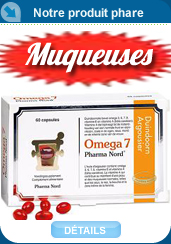ABC SANTE - Articles
11 mars 2020
Que faire en cas d’infections urinaires résistantes ?
| 11/03/2020 |
| 11/03/2020 |

 Les infections urinaires sont très fréquentes et souvent récurrentes chez les femmes, tant chez les jeunes filles qu’après la ménopause. Chez la femme, l’urètre est beaucoup plus court que chez l’homme. A cause de l’usage multiple d’antibiotiques, la plupart des agents pathogènes sont devenus multirésistants aux médicaments, si bien qu’ils n’ont plus que très peu d’effet. De plus, les microbes ont tendance à s’encapsuler à l’abri dans les « biofilms », ou même à se nicher dans les cellules de la paroi de la vessie. Les biofilms sont comme des « terriers », où les agents pathogènes se retrouvent pour se cacher. Ils y sont en lieux sûrs face aux antibiotiques et ils deviennent encore plus nuisibles. Et c’est ainsi qu’ils provoquent de nouveau des inflammations de la vessie.
Les infections urinaires sont très fréquentes et souvent récurrentes chez les femmes, tant chez les jeunes filles qu’après la ménopause. Chez la femme, l’urètre est beaucoup plus court que chez l’homme. A cause de l’usage multiple d’antibiotiques, la plupart des agents pathogènes sont devenus multirésistants aux médicaments, si bien qu’ils n’ont plus que très peu d’effet. De plus, les microbes ont tendance à s’encapsuler à l’abri dans les « biofilms », ou même à se nicher dans les cellules de la paroi de la vessie. Les biofilms sont comme des « terriers », où les agents pathogènes se retrouvent pour se cacher. Ils y sont en lieux sûrs face aux antibiotiques et ils deviennent encore plus nuisibles. Et c’est ainsi qu’ils provoquent de nouveau des inflammations de la vessie. Les composants bioactifs des canneberges empêchent que les bactéries puissent nidifier, si bien que ces dernières sont éliminées lors de la miction. Il est donc très important de boire suffisamment et de bien vider sa vessie en urinant.
Mais il a récemment été démontré que des concentrés de canneberges peuvent aussi attaquer le biofilm et donc le dispositif de sécurité des microbes. Et qu’ils ne s’attaquent pas seulement à la multirésistante E. Coli (cause la plus fréquente d’infections urinaires), mais aussi au champignon Candida albicans.
L'infection urinaire et cranberry
Problèmes de vessie, un désagrément typiquement féminin
Evitez une inflammation des voies urinaires avec des canneberges>
Traiter des infections urinaires sans antibiotique ?
Infection des voies urinaires : la nature plus salutaire que les antibiotiques
Sources:
Wawrysiuk S et al. Prevention and treatment of uncomplicated lower urinary tract infections in the era of increasing antimicrobial resistance-non-antibiotic approaches: a systemic review. Arch Gynecol Obstet. 2019 Oct;300(4):821-828.
Sun J et al. Pectic Oligosaccharides from Cranberry Prevent Quiescence and Persistence in the Uropathogenic Escherichia coli CFT073. Sci Rep. 2019 Dec 20;9(1):19590.
González de Llano D et al. Some New Findings Regarding the Antiadhesive Activity of Cranberry Phenolic Compounds and Their Microbial-Derived Metabolites against Uropathogenic Bacteria. J Agric Food Chem. 2019 Feb 27;67(8):2166-2174.
Samarasinghe S et al. The anti-virulence effect of cranberry active compound proanthocyanins (PACs) on expression of genes in the third-generation cephalosporin-resistant Escherichia coli CTX-M-15 associated with urinary tract infection. Antimicrob Resist Infect Control. 2019 Nov 20;8:181.
Baron G et al. Profiling Vaccinium macrocarpon components and metabolites in human urine and the urine ex-vivo effect on Candida albicans adhesion and biofilm-formation. Biochem Pharmacol. 2019 Nov 26:113726.
Wawrysiuk S et al. Prevention and treatment of uncomplicated lower urinary tract infections in the era of increasing antimicrobial resistance-non-antibiotic approaches: a systemic review. Arch Gynecol Obstet. 2019 Oct;300(4):821-828.
Sun J et al. Pectic Oligosaccharides from Cranberry Prevent Quiescence and Persistence in the Uropathogenic Escherichia coli CFT073. Sci Rep. 2019 Dec 20;9(1):19590.
González de Llano D et al. Some New Findings Regarding the Antiadhesive Activity of Cranberry Phenolic Compounds and Their Microbial-Derived Metabolites against Uropathogenic Bacteria. J Agric Food Chem. 2019 Feb 27;67(8):2166-2174.
Samarasinghe S et al. The anti-virulence effect of cranberry active compound proanthocyanins (PACs) on expression of genes in the third-generation cephalosporin-resistant Escherichia coli CTX-M-15 associated with urinary tract infection. Antimicrob Resist Infect Control. 2019 Nov 20;8:181.
Baron G et al. Profiling Vaccinium macrocarpon components and metabolites in human urine and the urine ex-vivo effect on Candida albicans adhesion and biofilm-formation. Biochem Pharmacol. 2019 Nov 26:113726.
























